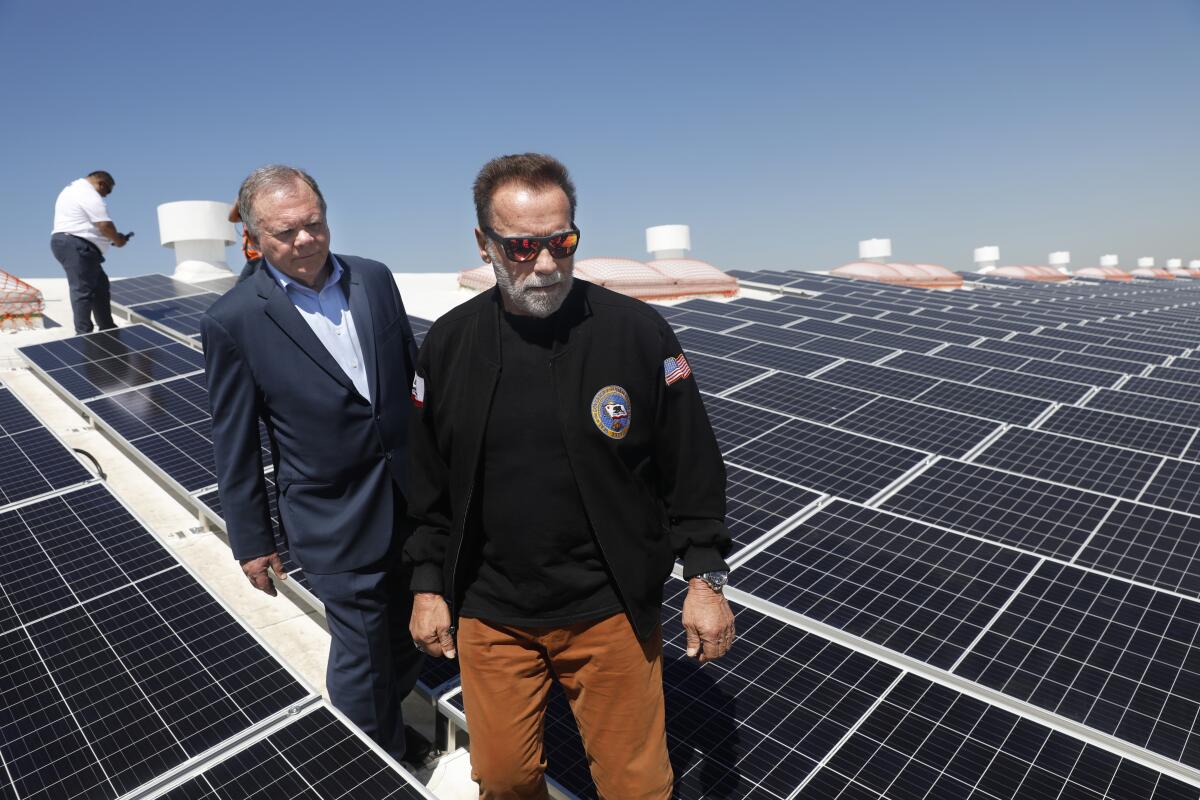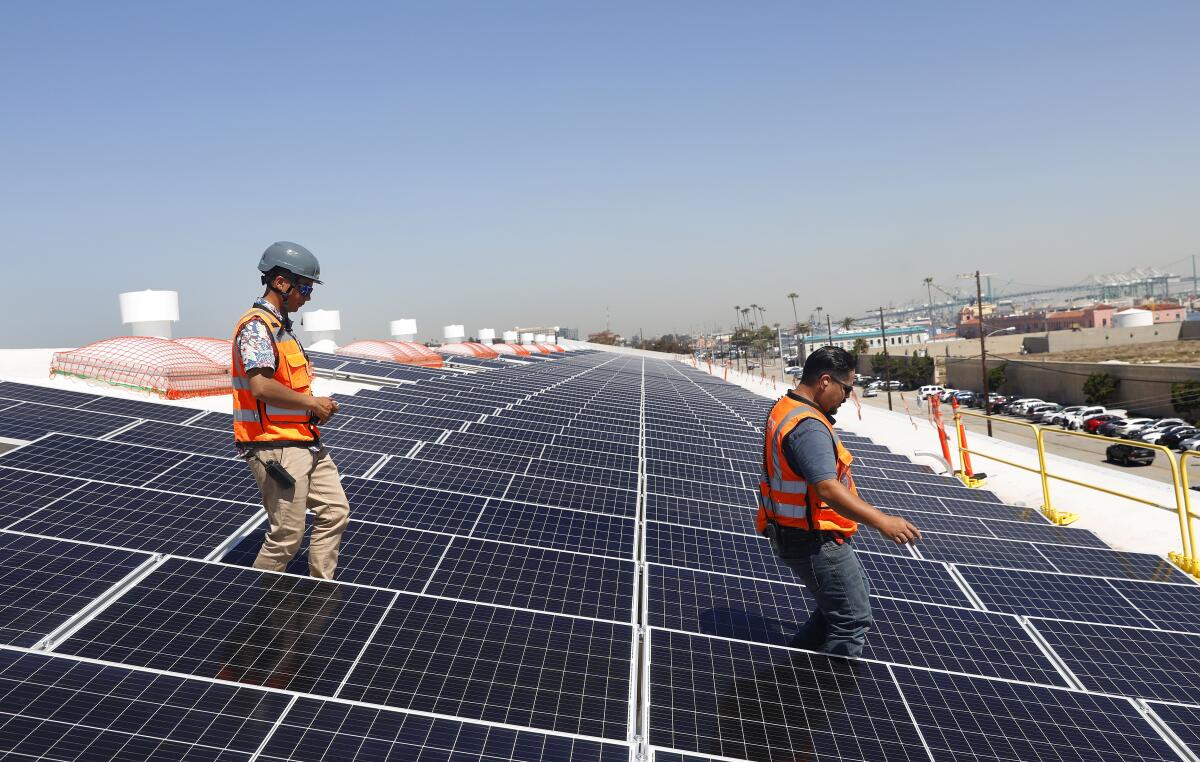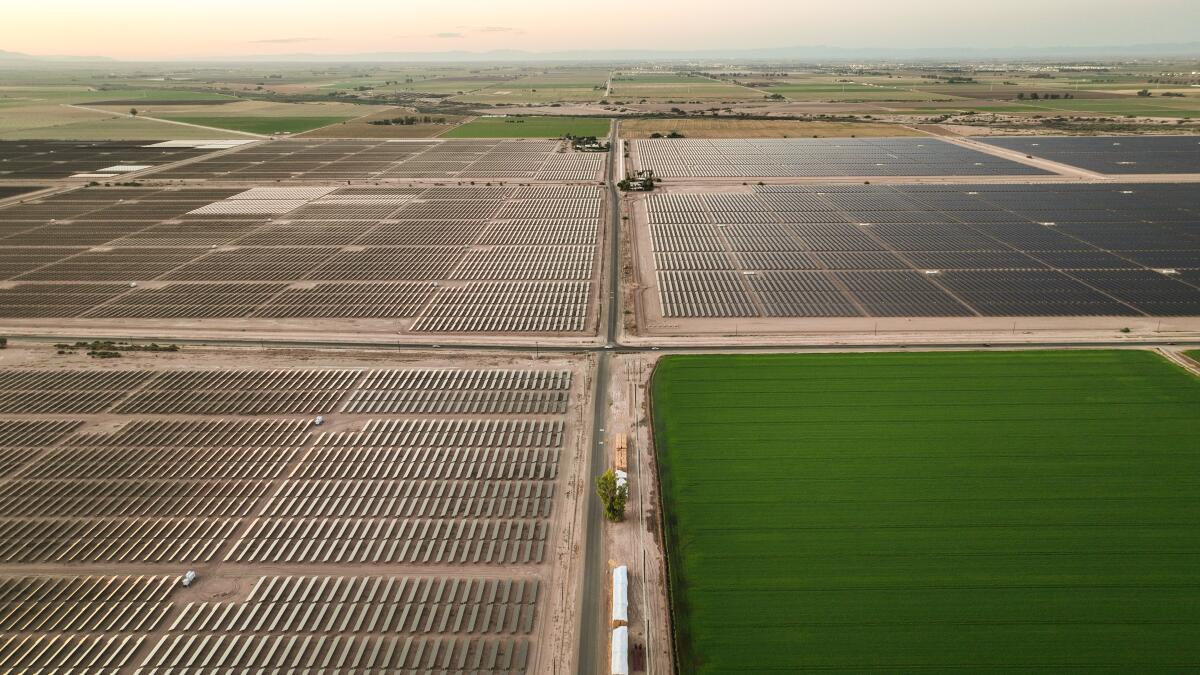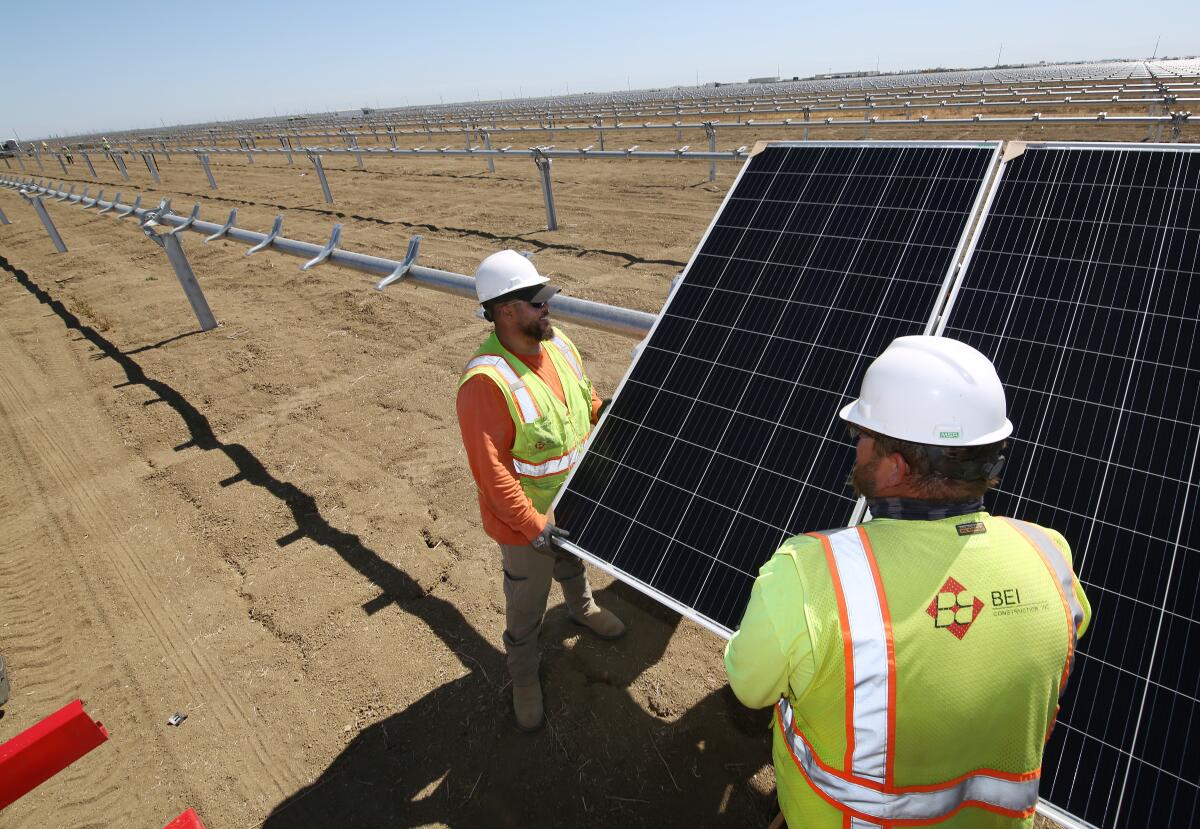Environmentalists sue California over reduced solar incentives

- Share via
This story originally published in Boiling Point, a newsletter about climate change and the environment. Sign up here to get it in your inbox.
The fate of California’s wildly successful rooftop solar incentives will be decided in court.
In a lawsuit filed Wednesday — and shared exclusively with The Times — three environmental groups argue that the California Public Utilities Commission acted illegally when it slashed compensation payments for power generated by solar panels. Gov. Gavin Newsom’s appointees failed to consider all the benefits of rooftop solar, and also ignored instructions from the state Legislature to ensure that solar adoption “continues to grow sustainably,” the environmental groups say in their lawsuit.
They’ve asked the California Court of Appeals to throw out the Public Utilities Commission’s December decision and order the agency to go back to the drawing board.
The courtroom battle could have significant implications for California’s efforts to phase out planet-warming fossil fuels and reach 100% climate-friendly energy — with ripple effects across the country.
More than 1.5 million homes and businesses have installed solar panels in the Golden State, thanks in large part to the net metering incentive program. If the lawsuit succeeds, rooftop solar installations could continue to grow rapidly, as they have for the last decade — meaning more clean electricity generated on urban buildings and parking lots, and less reliance on monopoly utility companies building long-distance power lines to carry electricity from large solar farms in the desert.
If the lawsuit fails and reduced incentives remain in place, rooftop solar installers expect a steep decline in business. That could mean more large solar farms and lengthy transmission lines — and higher profits for the utility companies building them.
It could also mean lower electric bills for the vast majority of Californians. Net metering critics say solar incentive payments are costing households without solar — including those who can’t afford rooftop panels — several billion dollars a year.

That so-called “cost shift” argument is hotly contested. Economists, ratepayer advocates and utility companies insist that rooftop solar incentives have fueled higher electricity rates, while most climate activists doubt the cost shift really exists.
After weighing the arguments for years, the Public Utilities Commission voted unanimously to dramatically reduce incentives for homes and businesses that install solar panels. The lower compensation rates took effect last month and apply to newly enrolled solar customers served by Southern California Edison, Pacific Gas & Electric and San Diego Gas & Electric.
Most environmental groups were furious — and a few decided to take their frustrations to court.
In their lawsuit, the Center for Biological Diversity, Environmental Working Group and Protect Our Communities Foundation accuse state officials of violating a 2013 law directing them to revise net metering “based on the costs and benefits” of rooftop solar. The law says the “total benefits” of the new incentive program should roughly equal the program’s “total costs.”
As far as the environmentalists are concerned, the Public Utilities Commission ignored several key benefits of solar.
One of those benefits is “resiliency” — the ability for rooftop solar panels, at least when paired with batteries, to power homes during outages on the larger electric grid. Solar-plus-storage systems can help people keep cool during dangerous heat waves, ensure life-sustaining medical equipment stays powered and prevent refrigerated food from spoiling.
Clean power produced by rooftop solar installations can also result in less pollution from gas-fired power plants in marginalized communities, and less wildlife habitat disrupted by large solar farms and long-distance transmission lines — additional benefits that the Public Utilities Commission failed to quantify before slashing incentives, the environmental groups say in their suit.
“You can’t short-shrift the benefit side of equation by just ignoring those, by saying they’re too hard to quantify,” said Roger Lin, an attorney at the Center for Biological Diversity. “The commission really left us no choice but to take this to court.”
I ran those arguments by Severin Borenstein, a prominent energy economist at UC Berkeley. He was skeptical.
Yes, Borenstein said, rooftop solar panels can help reduce pollution from fossil fuel infrastructure — but so can big solar farms in the desert. And yes, solar-plus-storage installations can help homes stay powered during blackouts — but that’s more a “private benefit to the customer” than a “societal benefit” that should be subsidized by other utility customers, he said.
The idea that rooftop solar panels can limit environmental damage from sprawling solar farms and long-distance electric lines “is a more significant argument,” Borenstein said. But he also noted that not all solar projects destroy sensitive wildlife habitat. Some are built on former farmland that’s already been radically altered by human activity, for instance.
“If that’s the case, then the impact is very different than if it’s pristine desert land,” Borenstein said.

Failure to account for all the benefits of rooftop solar power isn’t the environmental groups’ only legal argument.
They also say the Public Utilities Commission violated a section of the 2013 law requiring the agency to develop “specific alternatives” to net metering “designed for growth among residential customers in disadvantaged communities.”
In other words, the commission was supposed to promote rooftop solar adoption among low-income families that might not have been able to afford it. But environmentalists say the commission largely deferred this responsibility, jettisoning a proposed “equity fund” as unnecessary because the Legislature had recently voted to approve $630 million in solar and storage incentives for low-income homes — money that lawmakers could still choose to claw back in future budget cycles.
The commission should have created a dedicated program to support solar in low-income neighborhoods, the environmental groups say — such as a “community solar” initiative with small local solar fields to serve renters and apartment-dwellers.
“The commission kicked the can down the road for that issue,” choosing to address it in a separate rulemaking, Lin said.
A commission spokesperson declined my request for comment, except to say that the agency plans to consider an “application for rehearing” filed by the environmental groups — a formal request to reconsider the net metering decision — in June.
Edison and PG&E declined to comment. An SDG&E spokesperson said only that the utility company “abides by all decisions made by the California Public Utilities Commission,” and is “in the process of reviewing the merits of this legal challenge.”
But the commission and the utilities have argued previously that reducing net metering incentives is the best thing they can do for low-income families because those families pay the costs of the incentive program through their electric bills — a fundamental injustice that has benefited wealthier Californians who can afford solar.
Borenstein made a similar point when I asked him about the environmental groups’ lawsuit.
“This idea that we should be subsidizing rooftop solar in disadvantaged neighborhoods is really missing the point,” he said. “Disadvantaged neighborhoods have been hurt far more by rooftop solar in terms of the costs.”
I’ve spent plenty of time scrutinizing the “cost shift” debate in previous stories, and I won’t do it again here. But there’s an even more consequential question underlying that debate, which is what the nation’s clean energy future should look like.

Rooftop solar advocates envision a “distributed” energy future in which solar panels are largely installed on homes, warehouses and parking lots. They see the technology as crucial to stemming the fires, floods and heat waves of the climate crisis in a way that benefits individuals and families — rather than investor-owned utility companies such as Edison and PG&E.
Others counter that rooftop solar power is outrageously expensive compared with energy produced at scale at big solar farms, and that California can achieve its climate goals without net metering. It may even be easier to achieve those climate goals without net metering. If the solar incentive program keeps driving up electricity rates, critics say, fewer people will want to drive electric cars or heat their homes with electric heat pumps — crucial technologies for replacing oil and gas.
The lawsuit almost certainly won’t be the deciding factor in which of those futures the Golden State chooses. And when it comes to rooftop versus large-scale solar, it’s all a matter of degree. Researchers have found that California — along with the rest of the country — will need enormous amounts of both types of clean power to have any hope of ditching coal, oil and gas.
Whatever the courts decide on net metering, other states will likely be paying attention. California officials have long led the nation on promoting clean energy, and it’s common for lawmakers and regulators elsewhere to follow their lead.
Just in the last few months, Arkansas, Indiana and North Carolina have approved or affirmed reductions in solar incentives.
“We’re really concerned about a slippery slope,” Lin said. “If California creates this precedent for other states to follow, we would be playing right into the hands of the utility companies nationwide.”
ONE MORE THING

If you’ve been reading this newsletter or subscribing to The Times, you’re probably familiar with Rosanna Xia. She writes about the California coast and ocean, and was a Pulitzer Prize finalist in 2020 for her remarkable reporting on the rising sea.
Luckily for all of us, Rosanna has turned that reporting into a book. It’s called “California Against the Sea” and will be published in September. You can pre-order your copy here. I’ll have an early look in Boiling Point before it comes out, so stay tuned.
“My hope is that this book helps deepen the way we think about sea level rise — and what it means to live in better relationship with the shore,” Rosanna writes in a Twitter thread. “The California coast is the geographic soul of our state, and I cannot wait to share what I’ve learned with you.”
We’ll be back in your inbox on Tuesday. To view this newsletter in your Web browser, click here. And for more climate and environment news, follow @Sammy_Roth on Twitter.
Toward a more sustainable California
Get Boiling Point, our newsletter exploring climate change, energy and the environment, and become part of the conversation — and the solution.
You may occasionally receive promotional content from the Los Angeles Times.




